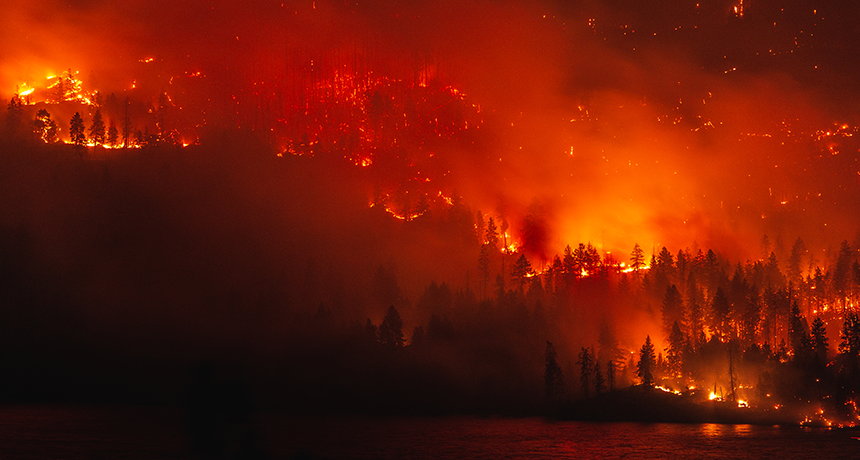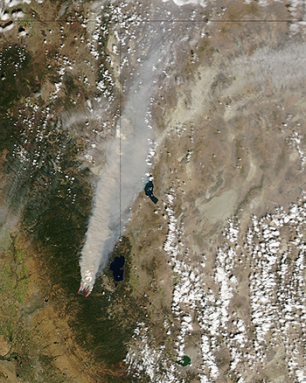Is climate change fanning megafires?
As wildfires grow in number and intensity, scientists look for the fingerprints of global warming

The biggest fire in California history ignited shortly after noon on July 27, 2018, and burned until mid-September. Called the Mendocino Complex Fire, its twin infernos started at the same time. They also burned close to one another and quickly blazed across forested lands. Together, they charred more than 1,800 square kilometers (700 square miles) — an area nearly half the size of the state of Rhode Island. Ninety crews of firefighters worked to contain it. They used hundreds of fire engines, 20 helicopters, 76 bulldozers and other tools. One firefighter died and four were injured. More than 150 homes burned, and smoke from the fire spread through the sky to nearby states.
Six of the state’s worst fires blazed in 2017 and 2018. A wildfire that burned through Napa Valley in October 2017 was particularly bad. Before it ignited, people who lived in the area described incredible winds that could knock a person over. Once the fire started, witnesses saw fires jump across roads, rip through vast fields of grapes and hop over hills. During more than three weeks, the fire claimed 22 lives, destroyed more than 5,000 structures and burned more than 146 square kilometers (56 square miles). That’s an area as big as one-and-a-half Disney Worlds. By year end, 2017 became California’s worst wildfire year on record.
Many areas across the world have seen a rise in extreme fires in recent years. Those include western U.S. states and southern Europe. They also include places you might not expect.
For example, wildfires used to be uncommon on Alaska’s North Slope. This region borders the Arctic Ocean and is home to the largest U.S. oil field. Now, however, fires are igniting there more frequently. The same is true in other Arctic regions. In July, for instance, people had to evacuate cities in northern Sweden as wildfires swept through them.
Some reasons for the rise in destructive fires are clear. People have been building homes on the edge of forests that face a high risk of fire. Periods of heavy rainfall can also spur a massive growth in vegetation. If that same area later experiences a drought — and California has suffered from many droughts in recent years — that new vegetation may dry out and become tinder that burns easily.
“The Napa Valley fires were a good example of this,” said Timothy Brown. He spoke during an online press briefing in August 2018. (It had been organized by a science communication project called SciLine.) During the briefing, experts talked about climate and weather. “Extreme precipitation in the winter and spring allowed for extensive [vegetation] growth,” he noted. “Then, when that dried later in the fall, it became very flammable and susceptible to ignition.” Brown is a climate scientist at the Desert Research Institute in Reno, Nev.
The signal of climate change
Has climate change made wildfires worse and megafires more likely? That’s what Brown and other climate scientists want to know. More importantly, they worry that more intense fires could become the new normal.
Studies have long predicted that warmer temperatures, due to climate change, make droughts and heat waves more likely. Many areas hit by recent fires had suffered through extreme droughts and heat waves.
But connecting individual fires to climate change is complicated. That’s partly because fire is complicated. Blaming climate change for any single fire is too simple. It ignores the natural conditions that make fire possible. But hotter days and warmer nights, caused by changes in the climate, do likely boost the risk of fire.
Scientists are still trying to agree on what makes a blaze ignite and spread. A wildfire has three main ingredients. First, it needs a spark. This can come from lightning or a downed power line. It can also come from negligent or malicious people who set fires by accident or on purpose. Brown points out that people start four out of every five wildfires. Second, a fire needs fuel to burn. This can be the trees in the forest or the dead “litter” — leaves, twigs and grass — on or near the forest floor. Finally, a fire needs weather conditions, like wind and no rain, to help it spread.
Many studies predict that climate change will boost the number of droughts and heat waves. Fire-ravaged areas, including California and Sweden, have had extreme droughts and extreme heat in recent years. Some scientists point to these weather events as proof that climate change makes wildfires worse.
But it’s even more complicated than that, says Janice Coen.
Fires can make their own weather
Coen is a meteorologist at UCAR. That’s the University Corporation for Atmospheric Research in Boulder, Colo. Testing hypotheses about fire is difficult, she explains. After all, scientists can’t go out and start a megafire. But she can make a computer model to test various ideas about the conditions that play a role in them. And that is exactly what Coen and her team did.
California’s 2014 King Fire burned for 27 days. During that time, it destroyed 12 homes. It was started by a man who recorded a selfie of himself right afterward. (He’s now in jail.) Coen wanted to know why the blaze raced so quickly through a forest canyon. To find out, she recreated the fire with a computer program. It used math to study how air particles move. It included data about temperature, humidity, air pressure and wind speeds. Those measurements had been collected by satellites, weather stations and special planes with onboard sensors.

These data helped her team explore why the King fire behaved as it did. Laws of physics “tell us what the answer ought to be,” she explains. Those answers can then help scientists predict how future fires will behave.
Some ecologists said the King fire burned so fast and so intensely because it had so much fuel. No fires had burned in that area for years. As a result, leaves and other plant debris had built up on the forest floor. Other researchers blamed the drought. But Coen found yet another culprit: the atmosphere. She reported her findings in the May Ecological Applications.
As a fire burns, it releases heat and water vapor, a gas. As that hot air rises, cooler air is drawn in at the bottom. This process creates a column of rising air. It also creates wind. In the case of the King Fire, those local winds drove the fire into new vegetation — more fuel, Coen’s team reported. As the fire grew, it created more wind, which made the fire more intense. That phenomenon, combined with the shape of the canyon, led to the fire’s rapid spread.
“Weather directs the fire,” she says. “The fire, in turn, can change the weather.” When she ran the simulated fire without drought conditions, the blaze behaved almost the same way. That suggests the long drought and heat wave had not worsened the fire. Instead, the canyon’s shape and local weather conditions had boosted its intensity.
The terrible fires that have ravaged California in 2018 arose from a complex mix of ingredients. These included the Santa Ana winds, which blow hot and dry through the state every fall. They also included a lack of the rain that usually develops in the cooler months. Less rain may be due to a La Niña event (a natural phenomenon that affects weather patterns worldwide). Some of those ingredients may have been worsened by climate change. But as Coen’s study points out, finding some clear fingerprint of climate change in wildfires is not easy.







